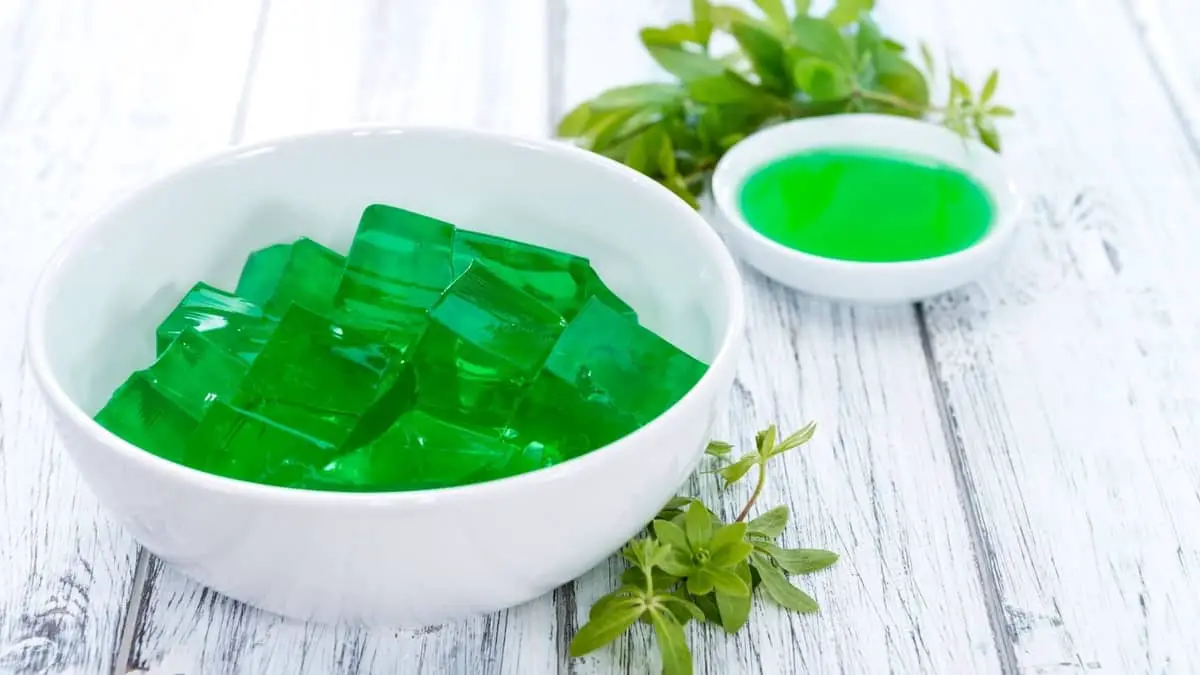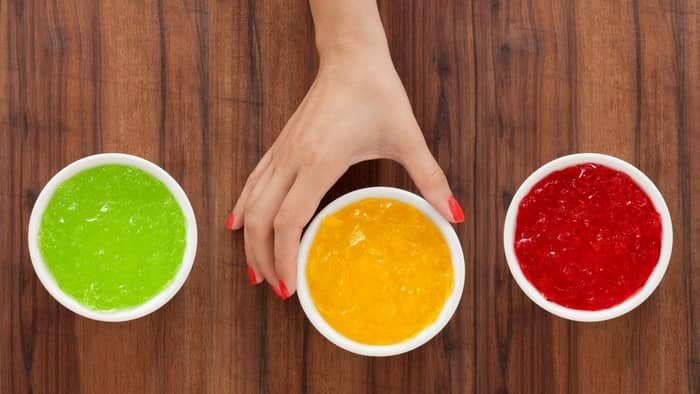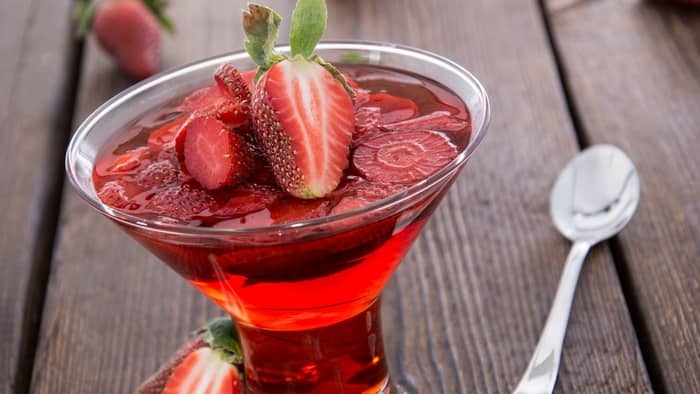Last Updated on February 7, 2023
Jello has become one of the most popular snacks, thanks to its jiggly texture and fruity flavor. Kids and adults alike both enjoy this one-of-a-kind food. So, you may wonder, how many calories is jello? Oftentimes, Jello has been a staple in many diet plans. However, this doesn’t necessarily make it healthy food to eat. It can still be a great snack to enjoy on occasion in moderation.
What is Jello?
Jello is a type of fruit-flavored dessert known for its signature jiggly texture. It comes in a variety of different fruit flavors and is often sold in a cup, though you can buy packets to make your own jello at home. The original jello dessert was made in the late 1800s and grew in popularity during the 20th century.
The primary ingredient in jello is gelatin, which helps give it its unique texture. In addition, it also contains water, fruit juice/flavoring, sugar, citric acid, and preservatives. Oftentimes, it will contain both natural and artificial flavorings.
When making jello from a packet, the powdered mixture is dissolved in hot water. Then, you stir cold water into the mixture and let it refrigerate for several hours. While in the fridge, it will gain its signature wiggly texture.
Jello cups are a great snack for packing in lunches or eating at home. They can last for three to four months at room temperature. Unopened cups can also last for up to one year when you store them in the fridge.
What is gelatin?
Gelatin is the most prominent ingredient in jello. Gelatin comes from collagen, which is derived from animal bones, tissue, and tissue. These body parts, often from cows and pigs, are boiled to get collagen.
Gelatin is a translucent, colorless, and flavorless ingredient used in a variety of different foods. It works as a stabilizer, thickener, or texturizer when it is added to different ingredients. It will not affect the taste of food, only the texture.
The most common foods that use gelatin as an ingredient include jello, marshmallows, gummy bears, fruit snacks, and trifles. Though not as common, you may also find it as an ingredient in yogurt, cream cheese, cheesecake, ice cream, and soup.
Since gelatin is made from animal products, it is not vegetarian or vegan-friendly. However, there are vegan substitutes that include agar-agar, carrageenan, and pectin that work like gelatin but are free of any animal products.
Learn more about How To Make Clear Gelatin.
Different Flavors
Jello cups come in many delicious different fruit flavors. The original fruit flavors include strawberry, raspberry, orange, and lemon-lime. You can also find other flavors such as cherry, raspberry, black cherry, strawberry kiwi, and fruit punch.
There are also sugar-free jello cups available as well in many different flavors. The sugar-free options use artificial sweeteners, such as aspartame and sucralose. They can be a good option for those who are on a sugar-free diet, as they are still a tasty treat.
Jello Cup Nutrition
Jello cups are a low-calorie, fat-free food, which makes them a popular addition to many different diets. However, this doesn’t necessarily mean that it is healthy food. They lack many necessary nutrients that make food healthy.
Jello cups are in sugar while they are low in fiber and protein, making them lack any important health benefits. Most jello cups have around 17 grams of sugar, with 16 of those grams being added. This is 33% of your daily value in sugar, as the Daily Value for added sugars is 50 grams a day for a 2,000-calorie daily diet.
However, many health experts recommend that women eat no more than 25 grams of added sugar a day and that men eat no more than 36 grams per day. This is based on recommendations from the American Heart Association.
Jello cups are also low in sodium and free of carbs and cholesterol. It provides virtually no vitamins, minerals, or fiber. However, though they are fruit-flavored, they do not provide any of the health benefits that fruit does.
Though there are sugar-free jello cups, that doesn’t necessarily make them a healthier option. Studies show that artificial sweeteners such as aspartame may cause inflammation and damage cells. In addition, there is also a link between artificial sweeteners and weight gain.
Factors that Affect Jello’s Caloric Content
Jiggly, wiggly, and oh-so-delicious, but did you know that this sweet treat can fit into a balanced diet? But don’t be fooled: not all jello is created equal. That is why we are going to dive into the factors that affect Jello’s caloric content and learn what you can do to make it a more nutritional alternative.
-
Flavor & Add-Ins
One of the most important elements influencing Jello’s calorie content is its taste. A 3 oz portion of cherry Jello, for example, has around 60 calories, whereas a 3 oz serving of chocolate Jello has about 70 calories. Besides that, adding fruit, whipped cream, or other additives might up the calorie content too.
-
Serving Size
As you can probably guess, calorie value is also affected by the size of the portion. Accordingly, a 3 oz portion of Jello has around 60-70 calories, whereas a 6 oz serving has approximately 120-140 calories. So, for those asking, “is jello fattening?” the answer is yes, but only if you eat too much of it. Therefore, if you want to watch your daily calorie intake, be sure to keep track of how much Jello you are eating.
-
Preparation Method
Jello’s calorie content can also be affected based on how it is prepared. Did you know that Jello made with skim milk instead of whole milk, for example, has fewer calories? Additionally, when compared to store-bought choices, preparing your own Jello at home with fresh fruit and a sugar alternative may considerably lower its calorie content.
How many calories are in a cup of jello?
You may wonder, how many calories are in jello? Well, a typical jello cup will have 70 calories in it. Though this does make it a low-calorie snack, it still lacks any beneficial nutrients while being high in sugar.
A sugar-free jello cup has just 10 calories in it. This makes it even a lower-calorie snack if you are trying to watch your calorie intake. However, you still need to factor in that it doesn’t contain any good health benefits if you are trying to eat healthy snacks.
Sugar-free Jello – The Sweet Treat That’s Actually Good for You!
Jello has been a staple dessert for generations, but with the rise of health consciousness, many people are looking for alternatives to traditional sugary treats. That’s why we have a real treat for you today! Our dear readers, we invite you to switch to the world of sugar-free Jello. This world’s favorite sweet and jiggly dessert just got even better. It is minimal in calories while also helping with blood sugar regulation!
So, what exactly is sugar-free Jello and how does it differ from the original? Let’s talk a bit more about sugar-free jello nutrition now, shall we? Things are actually rather easy! Instead of using sugar, this type of dessert is made with artificial sweeteners such as aspartame or sucralose. But what exactly does that mean? Is there any difference as a result of this? In principle, this actually means it has fewer calories and carbs, making it an excellent choice for those who are trying to lose weight or have diabetes.
Here are some details we believe you should be aware of:
It Has a Low-Calorie Content
One of the most significant advantages of eating sugar-free instead of traditional Jello is its low-calorie content. Well, how many calories is jello, that is, its sugar-free version? You may find it difficult to believe, yet a single serving (3 oz) has just 10-20 calories. It should be emphasized that everything depends on the flavor, so accordingly, there are some variations, however, it is nothing crucial.
That’s why, if you have the opportunity to choose between sugared and non-sugary options, we strongly advise you to go with the first one. In addition, as we have already stated, persons aiming to maintain a healthy weight shouldn’t hesitate to give it a chance since it may fulfill sweet cravings without adding extra calories to the diet. This is a really great way for all of us to enjoy a light snack without feeling guilty!
It Doesn’t Affect Blood Sugar Levels
Finally, we mustn’t overlook another significant advantage of sugar-free Jello. We aren’t sure whether you have considered this, but it doesn’t cause spikes in blood sugar levels like traditional sugary desserts. Therefore, if you haven’t already, now is the perfect time to start.
It Is Rich in Collagen
If you aren’t familiar, collagen is a vital protein for the human body, helping to maintain skin, hair, and nail health as well as healthy joints. It helps to keep skin appearing youthful and robust by providing structure and strength to various tissues. Finally, we mustn’t forget to mention that it has been shown to improve digestion and maintain gut health, making it an important vitamin for general health and well-being.
It Contains Small Amounts of Vitamins and Minerals
While it is true that the jiggly dessert is not a significant source of nutrients, it must not be overlooked that it does contain small amounts of vitamins and minerals that can contribute to overall human well-being.
Are you familiar with the fact that many brands of sugar-free Jello contain vitamin C? This is of crucial importance for boosting the immune system and fighting off illness. In addition, this powerful antioxidant protects the body from free radical damage, keeping skin looking young and vibrant.
Another nutrient found in sugar-free Jello is potassium, known for its ability to regulate blood pressure, support healthy muscle function, and keep the heart beating strong. So, to recap everything we have learned so far. The next time you are craving something sweet, freely, and without remorse go for a sugar-free Jello! This is a unique way to both satisfy your sweet tooth and provide your body with critical vitamins and minerals.
Now that you know how many calories is jello, let’s learn together about protein, shall we?
Jello – The Sweet Treat That’s Packed with Protein!
Yes, you have read that right – Jello is not only sweet and jiggly but it is also packed with protein! Although truth is told, Jello doesn’t include a considerable amount of protein, as does egg whites or chicken breast, it does contain small levels of this essential nutrient, making it a wonderful alternative for anyone seeking to add more protein to their diets.
So, how much protein is in jello? Well, buckle up, because we are about to embark on a flavor-filled journey to find out!
Depending on the flavor, a 3 oz serving of Jello contains 2-3 grams of protein. We know that many of you when you read this will not seem like much, but bear in mind that Jello is a low-calorie dessert and is not intended to be a major source of protein or any other nutrient.
A Popular and Tasty Snack
Jello is a popular snack thanks to its tasty fruit flavors and jiggly texture. It is fat-free and low in calories, with approximately 70 calories a cup, with sugar-free having just 10 calories. However, regular jello is high in calories and lacks any important nutrients.
Though health experts do not consider jello cups to be a healthy snack, you can still enjoy them on occasion as a special treat. They can keep unopened in your pantry for up to three to four months and in your fridge for up to one year. They do not freeze well, as it will mess up the desirable texture and make it not as tasty.
There are many great flavors to choose from including strawberry, raspberry, orange, lemon-lime cherry, raspberry, black cherry, strawberry kiwi, and fruit punch. However, it is important to remember that it contains gelatin, which comes from animal bones, skin, and tissue. So, if you are vegan or vegetarian you will want to avoid traditional jello.
Do you have any questions regarding how many calories is jello? If so, please ask any questions regarding jello and its nutrition facts in the comment section down below.
Read more about How Long For The Jelly To Sit At Room Temperature.

Ever since she was a young girl, Anna has been a lover of desserts. As an adult, she enjoys
baking a variety of desserts from cakes, cookies, brownies, bread, and more from scratch. She
enjoys sharing her passion for baking with others who also have a sweet tooth. From properly
measuring ingredients to making sure they are the correct temperature, Anna knows the
importance small details can make in baking. She wants to share her experience with others in
hopes they can make the most delicious baked goods. When she’s not busy blogging, Anna
enjoys trying new recipes in the kitchen.



